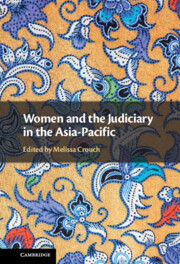Book contents
- Women and the Judiciary in the Asia-Pacific
- Women and the Judiciary in the Asia-Pacific
- Copyright page
- Contents
- Figures
- Tables
- Preface
- Contributors
- Abbreviations
- 1 The Feminisation of the Judiciary in the Asia-Pacific
- 2 ‘To Join the Bench and Be Decision-Makers’
- 3 Reframing Feminist Imperatives in Adjudication through a Reading of Sri Lankan Jurisprudence
- 4 Women in the Thai Judiciary
- 5 The Promise and Paradox of Women Judges in the Judiciary in Indonesia
- 6 Filipino Women Judges and Their Role in Advancing Judicial Independence in the Philippines
- 7 One Decade of Female Judges in the Malaysian Shariah Judiciary
- 8 Gender on the Bench Matters for Sustainable Development
- 9 Feminising the Indian Judiciary
- 10 Concluding Remarks
- Index
- References
8 - Gender on the Bench Matters for Sustainable Development
Examining Women in the Judiciary of Nepal through the Lens of Motility
Published online by Cambridge University Press: 21 October 2021
- Women and the Judiciary in the Asia-Pacific
- Women and the Judiciary in the Asia-Pacific
- Copyright page
- Contents
- Figures
- Tables
- Preface
- Contributors
- Abbreviations
- 1 The Feminisation of the Judiciary in the Asia-Pacific
- 2 ‘To Join the Bench and Be Decision-Makers’
- 3 Reframing Feminist Imperatives in Adjudication through a Reading of Sri Lankan Jurisprudence
- 4 Women in the Thai Judiciary
- 5 The Promise and Paradox of Women Judges in the Judiciary in Indonesia
- 6 Filipino Women Judges and Their Role in Advancing Judicial Independence in the Philippines
- 7 One Decade of Female Judges in the Malaysian Shariah Judiciary
- 8 Gender on the Bench Matters for Sustainable Development
- 9 Feminising the Indian Judiciary
- 10 Concluding Remarks
- Index
- References
Summary
The feminisation of the legal profession has become a policy priority in developed and developing nations. Although an increasing number of female students have chosen to pursue law education in the South Asian nations like Nepal, the state of women representation in the judiciary remains unsatisfactory. For example, less than one-tenth of advocates as well as judges in Nepal are women. Drawing on the construct of motility – the capacity of actors to be mobile in social settings – this chapter asks: 'what insights can be generated from the current status of women in the Nepalese judiciary?’ The chapter adopts an exploratory research approach in order to analyse primary data (six interviews with retired, sitting and aspiring judges) and publicly available secondary data (key policy documents, media reports). The findings reveal three key themes: (a) barriers to enter judiciary (i.e. glass door), (b) challenges in maneuvering the career ladder (i.e. path of broken glass) and (c) the lack of opportunities to occupy key leadership positions (i.e. glass ceiling). Based on the findings, the paper suggests two policy propositions that can be considered to foster women representation in judiciary in developing countries like Nepal.
- Type
- Chapter
- Information
- Women and the Judiciary in the Asia-Pacific , pp. 235 - 260Publisher: Cambridge University PressPrint publication year: 2021



